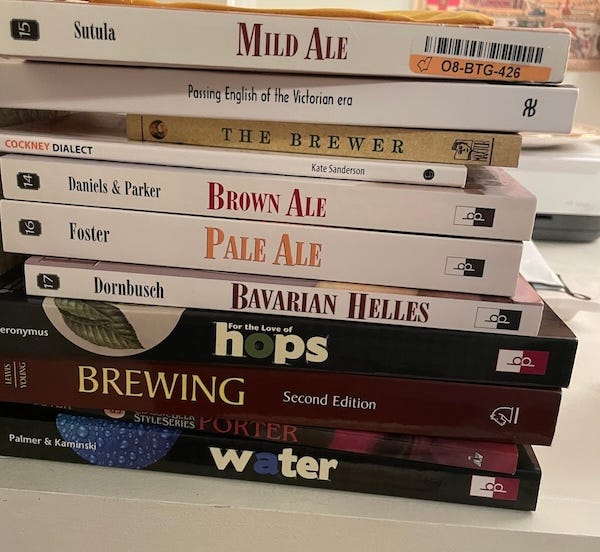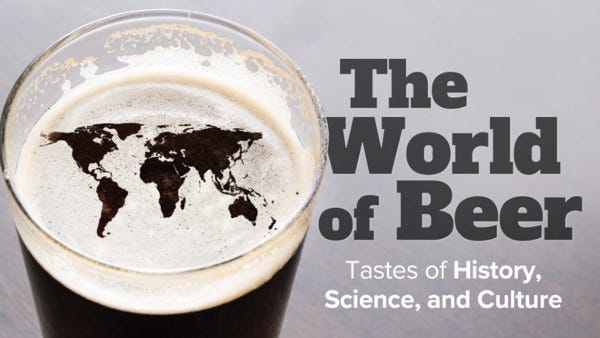I recently returned from a 10-day research trip to the UK, where I was gathering material for three upcoming novels. In both my work as a historical romance author and a technical communicator, my job is the same: explaining complicated things to people and getting people to care about complicated things. Whether you’re an engineer, a history lover, a romance reader, or some glorious combination of all three, this series is for you.
Brewing Series:
Article 1: Everything is Beer
Article 2: Touring Historic English Breweries
Article 3: Women, Witches, Wort, and Wi-Fi: The Systemic Silencing of Women
Learning more about 19th-century industrial brewing is what took me to England in the first place. I needed to learn the ins and outs of large-scale brewing in 1851 for the second book in my series. After reading stacks of books, watching YouTube videos, and taking two Great Courses, I’d reached the limit of the knowledge to be gained secondhand.
Everything is Beer
This article is named in honor of John Green’s excellent book, Everything is Tuberculosis, which I just finished reading. You should drop everything and read it. It is a beautiful melding of memoir, science, policy, and history.
John writes that the more he learned about tuberculosis, the more he saw TB everywhere. It became a lens that connected a thousand disparate stories together. I went to England to learn about beer. And soon, I started seeing everything through the lens of beer.
And let me tell you: everything is beer.
Beer is chemistry. It is sociology. It’s archaeology. It’s the history of food, and the history of us. Beer (or, actually, ale) has been used to elevate women and subjugate those same women. It birthed germ theory and food safety laws. If you’re thankful that your milk doesn’t give you tuberculosis or that your doctor knows to prescribe antibiotics, thank beer.
Simply put, there wouldn’t be people without beer.

Research Runneth Over
I came with a list of questions – some incredibly specific and others quite vague. Like a beer’s foamy head flowing over a pilsner, the visits were more fruitful than I could have imagined. In fact, it’s taken me several weeks of pondering to even determine how to share it with you. And the truth is, I’m keeping a lot of what I learned tucked away because it’s specific to the plot of my next book. Like my article about visiting the archaeological dig, I’m going to have to write around some of the big things in the center.
In the end, I decided to write three articles about my visits to two of England’s historic breweries, plus this preamble. Because my Substack examines the intersection of historical romance and STEM, it was the only way to logically organize all the malty thoughts swirling around in my head.
Article 1: The Grand Tour
Article 2: Beer’s role in elevating and oppressing women
Article 3: Beer as a way to understand transferable technology in science and engineering
Pre-Trip Research, or A Celiac Walks into a Brewery
As you know, I love research. After years of writing about the most complex academic STEM research, I want to understand a thing three layers deep before I write about it. Funny thing is, when it comes to beer, I have very little first-hand knowledge and am unable to acquire much more.
I was diagnosed with celiac in 2006, the year I started graduate school. I didn’t go through a beer phase at my Baptist university, and let’s be honest, the beer the college kids were drinking was not exactly from craft microbreweries. They were decidedly not discussing the origins of the hops.
For the last year and a half, I’ve read dozens of books on breweries and taken two Great Courses. And so, armed with book knowledge, I reached out to a few select historic breweries to schedule visits. It was always funny to end each of those conversations with “Oh, and by the way, I have celiac disease. I can’t actually drink any of your liquid gluten.”
This sounds like the first half of a joke…A celiac walks into a brewery to write a book about beer.
Alas.
Some of my favorite resources
Here is a stack of books I’ve read (with a few dialect books accidentally thrown in). I’ve read or skimmed all of these.
The Meaning of Beer by Jonny Garrett is, without a doubt, my favorite book on the history of beer. I recommend reading this in conjunction with Everything is Tuberculosis. You’ll see the parallels.
Porters & Stouts by Terry Foster — The back half of this book is recipes, but the front half has incredible history about this London brew named after the porters who drank it.
The Brewer: A Familiar Treatise on the Art of Brewing, 1856 — This book, printed in 1856, is a delight! I love reading about beer from the people of the time I’m writing about.
Great Course: Everyday Guide to Beer by Charles W. Bamforth
Charlie Bamforth is a professor of Beer at the University of California, Davis. He is considered the worldwide expert on all things beer and brewing. He goes through each major kind of beer — its flavor profile and history. Interestingly, he also has celiac. Solidarity, Charlie!
Tip: A monthly subscription to the Great Courses app is something like $20…far cheaper than buying a single course.
The World of Beer: Tastes of History, Science, and Culture by J Jackson-Beckham, Ph.D. — If you want to know the story of beer, its history in different civilizations, this is the great course for you.
Tip: A monthly subscription to the Great Courses app is something like $20…far cheaper than buying a single course
Thanks for reading. Check out Article 2 where I bring you along to tour two historic breweries in England!









